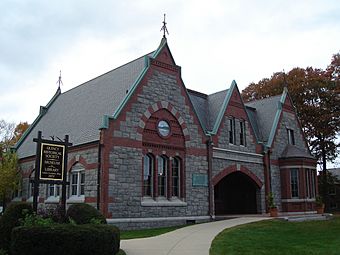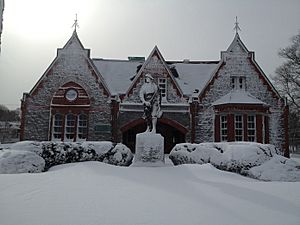Adams Academy facts for kids
|
Adams Academy
|
|

Front of the Academy building
|
|
| Location | 8 Adams Street, Quincy, Massachusetts |
|---|---|
| Built | 1869 |
| Architect | Ware & Van Brunt |
| Architectural style | Late Gothic Revival |
| NRHP reference No. | 74000379 |
Quick facts for kids Significant dates |
|
| Added to NRHP | September 6, 1974 |
| Designated NHL | April 19, 1994 |
Adams Academy was a special school that opened in 1872 in Quincy, Massachusetts, United States. It was created thanks to John Adams, who was the second President of the United States. Many years before the school opened, he set up a fund called the Adams Temple and School Fund. This fund gave about 160 acres (0.65 km²) of land to the people of Quincy.
President Adams wanted this money and land to build a school. He wanted it to honor his good friends, John Hancock and Josiah Quincy. They all lived in Quincy, Massachusetts. John Hancock's birthplace was even on some of the land given for the school.
Contents
How Adams Academy Started
John Adams, the second President of the United States, lived in Quincy, Massachusetts his whole life. In 1822, when he was in his eighties, he gave several important gifts to the town. One gift was land and money to build the First Parish Church. Another gift was part of his personal library.
His third gift was for starting a local school. This gift included 8 acres (3.2 ha) of land in the center of Quincy. He also asked for a stone building to be built, ideally from Quincy granite. This granite came from Adams' own land. He even gave advice on what to teach and how to teach it. Adams created the Adams Temple and School Fund to manage these properties.
The church was built first in 1828, as Adams had instructed. However, the school took longer to build. This was because it had only a small amount of money at first. By 1868, the fund had grown enough to start building the school. Adams' grandson, Charles Francis Adams, Sr., was in charge of the Fund. He asked architect Henry Van Brunt to design a suitable building. The Fund board approved Brunt's plans in January 1870. He worked with William Robert Ware on the design. The building was finished that year and cost $29,000.
History of the School
Adams Academy welcomed its first students in 1872. It stayed open until 1908. The most students it ever had was 140 in 1876–77. The school was set up like other famous schools, Phillips Academy and Phillips Exeter Academy.
Adams Academy focused a lot on teaching classics, like ancient Greek and Latin. Students at Adams Academy were prepared to attend Harvard. However, by the early 1900s, public schools in the area had gotten much better. There was also more competition from other private schools. Because fewer students were enrolling, Adams Academy closed in 1908.
What Happened to the Building Later
After Adams Academy closed, the Adams Temple and School Fund looked for new ways to use the building. They wanted to make sure the new use still fit John Adams' original wishes. For many years, different community groups used the building. These included the Boy Scouts, the American Legion, and the Red Cross. In the 1950s and 1960s, it was even home to the local military draft board.
In 1972, the building was leased to the Quincy Historical Society. This was first suggested way back in 1934. The Society now uses the building as a museum and for its library. The people in charge of the Fund, who include Adams' family members, believe these uses fit John Adams' original goals.
Adams Academy Today
The Adams Academy building was added to the National Register of Historic Places in 1974. It was then named a National Historic Landmark in 1994. You can find it at 8 Adams Street in Quincy.
Images for kids







